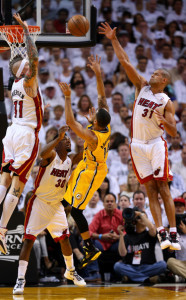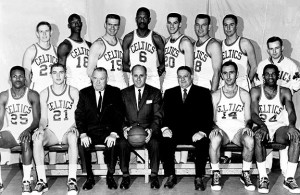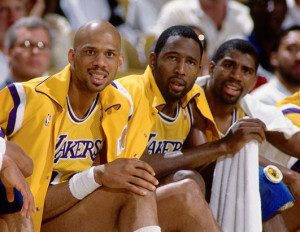Miami Heat Are Great, But Not GREAT

The 1973 New York Knicks featured six future Hall of Fame players as well as one player (can you recognize him in this photo?) who would go on to become a HOF coach.
There has been quite a bit of discussion in recent weeks regarding how the current Miami Heat compare to some of the great teams in NBA history.
A pair of Hall of Famers and former New York Knicks stars Walt Frazier and Earl “The Pearl” Monroe have especially been criticized for daring to suggest that while the Heat are an excellent team, they have no business being considered among the great teams in NBA history.
It seems popular in our current society to think that whatever is happening now is “bigger”, “better” and “greater” than anything that could have ever happened in the “old days”. To today’s 20-somethings, NBA history means acknowledging that there was indeed a league before LeBron James and past stars like Magic Johnson, Michael Jordan, Larry Bird and Kareem Abdul-Jabbar are better known as television pitch-men than for anything they ever did on the court.
To the current generation, the standard for a “great” team has been a squad with two or three legitimate All-Stars and then a collection of solid role players. That model actually dates all the way back to the Chicago Bulls teams of the 1990s when Jordan, Scottie Pippen, Horace Grant (for the first three)/Dennis Rodman (for the last three) and a bunch of guys who made occasional contributions and filled specific roles won six titles.
Of course the “big three” of LeBron James, Dwyane Wade and Chris Bosh are the latest and greatest example of this strategy for building a team. Since their celebrated move to Miami in 2010 this group has led the Heat to a pair of appearances in the NBA Finals and the 2012 title. This season the Heat won 37 of their final 39 games, including 27 straight, and appear poised for another title run.

Chris Andersen, Norris Cole and Shane Battier will never be confused with the other “big three” in Miami.
That the Heat rely on their top three players could be an understatement. The trio accounted for 63% of the scoring for the squad while shooting for a much higher percentage than their teammates and also producing a majority of assists, rebounds, steals and blocks for the squad. The only other player to average in double figures during the regular season was Ray Allen (10.9 ppg), who was once famously part of another “big three”, but is now another of the role players on the current Miami squad.
This framework for a championship squad is quite different than how championships teams were built from the 1950s through the 1980s. In many cases, those were teams that included two or three top-line superstars, but rather than surround them with a collection of role players who accounted for a small percentage of points, rebounds and other key statistics, the other players were often also All-Star caliber players who helped create a formidable powerhouse.
As time goes on and the memory of the great Boston Celtics teams of the 1950s and 1960s becomes more distant it is easy to dismiss that group as being built around Bill Russell and Bob Cousy with the rest of the players being secondary performers. However, while Russell and Cousy were all-time greats, the success of the Celtics was built around having multiple stars that each filled a key role.
In 1961-62, the Celtics won 60 games for the first time with a squad that had five different players averaging at least 15 points per game, led by Tommy Heinsohn at 22.1 points per game. Bill Russell averaged 18.9 points and 23.6 rebounds while Sam Jones (18.4 ppg, 5.9 rpg), Cousy (15.7 ppg, 7.8 apg) and Frank Ramsey (15.3 ppg) helped the team average 121 points per game. In addition, Tom Sanders, who was in the second year of his 13 year career, averaged 11.2 points and 9.5 rebounds. In addition to these six future basketball Hall of Famers, the Celtics also included K.C. Jones (9.2 ppg, 4.3 apg) and Jim Loscutoff (5.3 ppg, 4.2 rpg).
Interestingly, the six future Hall of Famers on the 1961-62 season was not the most ever for the Celtics. Both the 1957-58 and 1962-63 squads included eight future Hall of Famers.
Part of why Frazier and Monroe may not be overly impressed with the overall makeup of the Heat is that when the New York Knicks won the NBA title in 1969-70 and 1972-73 their squads included a high number of future Hall of Famers, as well as other standout performers.
The 1969-70 Knicks won 60 games during the regular season led by Willis Reed (21.7 ppg, 13.9 rpg) and Walt Frazier (20.9 ppg, 8.2 apg). Dick Barnett (14.9 ppg), Dave DeBusschere (14.6 ppg, 10.0 rpg), Bill Bradley (14.5 ppg) and Cazzie Russell (11.5 ppg) all scored in double figures. Backup center Dave Stallworth (7.8 ppg, 3.9 rpg) and guard Mike Riordan (7.7 ppg, 2.5 apg) were also key contributors. Reed, Frazier, DeBusschere and Bradley are all in the Hall of Fame while Barnett and Russell each were All-Stars during their career.
By the time the Knicks won their second title in 1972-73, the team had six Hall of Famers on the roster. In addition to the “big four” from their earlier championship squad, future HOF members Monroe and Jerry Lucas also were key contributors. That squad also included a number of other solid NBA players including Barnett, Phil Jackson, Henry Bibby, John Gianelli and Dean Meminger.
In the 1980s, both the Celtics and Los Angeles Lakers won multiple titles by stocking their roster with high caliber players.
While for much of the decade the Lakers were led by the Hall of Fame trio of Kareem Abdul-Jabbar, Magic Johnson and James Worthy, the team also had future Hall of Famers Jamaal Wilkes and Bob McAdoo in the lineup for a number of years. In addition, such All-Star caliber players as Byron Scott, Norm Nixon, Michael Cooper, Kurt Rambis, Eddie Jordan, Mitch Kupchak, A.C. Green and Mychal Thompson were among those who helped the Lakers win five titles during the decade.
The Celtics also had a “big three” during the 1980s in future Hall of Famers Larry Bird, Robert Parish and Kevin McHale, but like the Lakers, had a rotating group of HOF or All-Star caliber players to support them.
During their 1980-81 championship season, five Celtics scored in double figures, led by Bird (21.2 ppg, 10.9 rpg), Parish (18.9 ppg) and Cedric Maxwell (15.2 ppg), future HOFer Tiny Archibald (13.8 ppg, 7.7 apg) and McHale (10.0 ppg). In addition, Rick Robey (9.0 ppg), Chris Ford (8.9 ppg), Gerald Henderson (7.7 ppg) and M.L. Carr (6.0 ppg) were also key contributors.
Archibald was no longer on the squad when they won the 1984 title, but another Hall of Famer, Dennis Johnson, filled the role as the Celtics had six players average double figures.
Ironically, the Detroit Pistons won their first NBA title during the 1988-89 season after trading Hall of Famer Adrian Dantley to the Dallas Mavericks during the season. Instead, Mark Aguirre, who has yet to be inducted into the HOF despite averaging 20 points per game for his career, proved to be the key ingredient to add to a lineup that included Hall of Famers Isiah Thomas, Joe Dumars and Dennis Rodman, the Human Microwave Vinnie Johnson and Bad Boys Bill Laimbeer, James Edwards, Rick Mahorn and John Salley.
While the current Miami squad is staking a claim to be the best team of their era, given the great depth of some of the championship teams from NBA history, is a squad that relies on Mario Chalmers, Chris Andersen, Mike Miller and Udonis Haslem really worthy of a place at that table?
To some Frazier and Monroe may seem like grumpy old men, but a closer review of history illustrates that sometimes you really should listen to your elders.


That's Phil Jackson! The greatest coach of all time!
Dave Stallworth was actually a backup forward on the Knicks' 1969-70 team. He usually came off the bench to replace Dave DeBusschere.. He did guard Wilt Chamberlain in Game 5 of the NBA Finals that year, but generally he played what today would be considered the power forward position.
Nate Bowman was the primary backup center on the team. He went to Buffalo (now the Clippers) in the expansion draft, as did the second backup center, Bill Hosket.
Bowman was 6-10. Hosket was listed at 6-8. Stallworth was 6-7.
Yeah, this time is considered a great team but this fact can also not be denied that Miami Team though plays well but not that well like the games played by the teams in the history. Hence, there are many discussions and arguments regarding their performance.
Im glad to have found this post as its such an interesting one! I am always on the watchout for quality posts and articles so i suppose im lucky to have found this! I hope you will be adding more in the future…xlslot88
I and my friends were found to be looking at the nice ideas on your web page then quickly I had a horrible suspicion I never expressed respect to the web site owner for those secrets. My women came for this reason very interested to see all of them and already have sincerely been tapping into those things. Appreciation for actually being well thoughtful and also for figuring out these kinds of very good subject areas most people are really desirous to be aware of. Our own sincere apologies for not saying thanks to earlier.check my site
I am crazy about this blog. I have visit so many time to this blog. I was found this blog from Google. I have received a nice stuff of information. I really appreciate to meet to it and i emphasize to this blog. My curiosity to learn more and more on this blog.xlslot